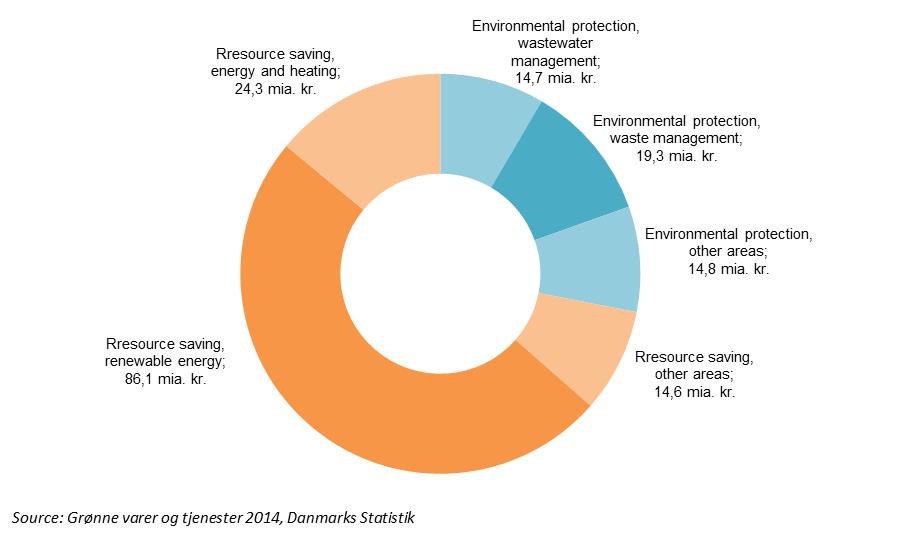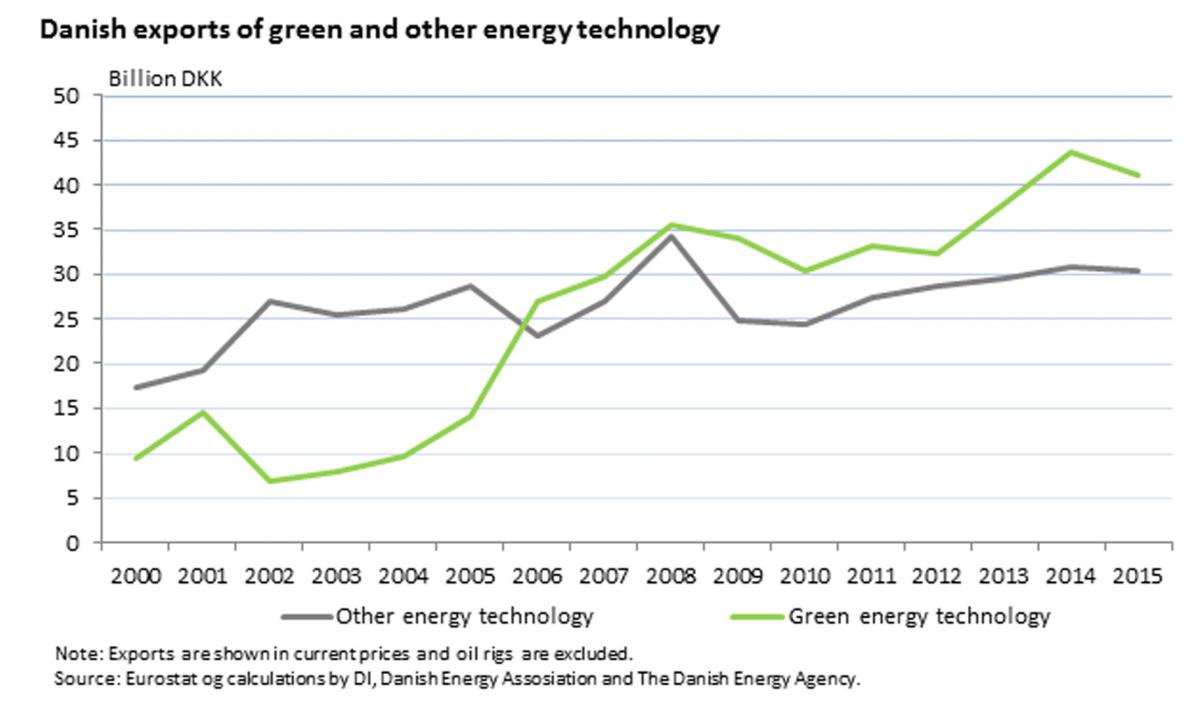Green growth refers to economic growth that uses resources in a sustainable manner. This is done by production and exchange of green or environmental goods and services. In the following the definition used by Statistics Denmark applies. Statistics Denmark compiles the Danish contribution to the Environmental Goods and Services Sector Accounts in Eurostat. Environmental products are goods and services that are produced for the purpose of preventing, reducing and eliminating pollution and any other degradation of the environment and preserving and maintaining the stock of natural resources and hence safeguarding against.
Research and development within the field is also included.
Environmental awareness has increased over the last decades. This has increased the interest for production of green goods and services, both nationally and internationally. Sales and exports of green solutions to the global market are the main drivers of the green growth in Denmark. The increased focus on green growth and green transition worldwide increases demand for Danish technology and knowhow.
Investment in the green transition is important not only due to climate challenges, but also to ensure security of supply and enable the Danish economy to become independent of unstable energy prices and scarce resources. It also supports and improves the competitiveness of Danish businesses in the global market for green solutions.
The market for green technology is expected to grow in the future as more countries prioritise a green agenda.
The green transition is an opportunity for Denmark to strengthen the domestic market for green energy and climate solutions as much as an opportunity to demonstrate green solutions on a large scale. This increases the possibilities for Danish businesses to export to the growing global market.
The possibilities to test and demonstrate new green technology also attract foreign companies, who see an opportunity for testing their products in an advanced energy system with a high level/share of renewable energy.]
Green production in Denmark contributes significantly to the Danish economy. In 2014 Denmark produced green goods and services worth a total value of DKK 174 billion. Exports of green goods and services accounted for DKK 72 billion, which equivalents to 7 pct. of total Danish exports. 59.000 people are employed full time within the green sector, corresponding to 2.7 pct. of total employment in 2014.
Environmental products are goods and services that are produced for the purpose of preventing, reducing and eliminating pollution and any other degradation of the environment and preserving and maintaining the stock of natural resources and hence safeguarding against depletion1.
Statistics Denmark publish the statistics Green Goods and Services yearly (Grønne varer og tjenester), the most recent with data for 2014. The statistics is produced in order to monitor, on at statistical basis, the development in the green production and businesses in Denmark across time and determine its significance in the Danish economy and the numbers are used as common reference point when discussing green growth in Denmark.
According to the statistics, Denmark produced green goods and services worth of 174 billion Danish kroner (DKK) in 2014. This is an increase of 9 billion (5.5 pct.) compared to 2013. Just under half of this production (86.1 billion DKK) was related to renewable energy while the turnover of products that increase energy efficiency was 24.3 billion DKK.

Main takings from the publication Grønne varer og tjenester 2014
- Denmark has exported green goods and services worth of DKK 72 billion in 2014, which is an increase of 9.5 pct. from 2013. The machinery industry represents a remarkable DKK 46 billion of the export, due to the production of wind mills. The industry in total represents DKK 62 billion (86 pct.) of the total exports of green goods and services. Green goods and services totals 6.9 pct. of Danish exports overall in 2014.
- 59.000 people are employed full time within the green sector, corresponding to 2.7 pct. of total employment (2014). Two thirds work within production of green products aimed at resource savings, while the remaining third develop/produce products and services aimed at protecting the environment. 48 pct. of the “green” jobs are in the industrial sector.
- The value added from production of green goods and services was DKK 60 billion in 2014. Accounting for 3.1 pct. of the Danish GDP.
- Generally “green” firms are more active within research and development than “non-green” firms. Hence 77 pct. of “green” firms are categorised as innovative while the number for “non-green” firms is 66 pct.
The statistics can be found here at Statistics Denmark - StatBank
For a more thorough report available in English on the importance of green production in Denmark read the 2012 'Green production in Denmark - and its significance for the Danish economy'.
1 ec.europa.eu/eurostat/statistics-explained/index.php/Environmental_goods_and_services_sector
Many years of active Danish policy on energy and climate has created possibilities for development of new export products based on green technology.
The export of Danish energy technology has increased the last 15 years. The total Danish export of energy technology was DKK 71.4 billion in 2015, which is a decrease of 4 pct. compared to 2014. The export of energy technology was 11 pct. of the total Danish export in 2015. That puts Denmark in front within the EU when it comes to the share of energy technology of total exports of goods.
This is stated in the analysis from The Danish Energy Agency, Danish Energy Association (DE) and The Confederation of Danish Industry (DI).

The main points from the analysis are:
- Exports of plants for renewable energy and energy saving solutions were DKK 40.9 billion in 2015. This accounts for 6.4 pct. of total goods exports, which is a reduction of 8.7 pct. compared to 2014. This primarily results of a reduced export to the EU, which is the largest market for Danish energy technology.
- Exports of other energy technology had a value of DKK 30.4 billion. This is a decrease of 3.8 pct. compared to 2014. This category includes energy production based on fossil fuels.
- The export figures show that export of energy technology contributes significantly to Danish economy. The EU is the main market for Danish energy technology. Germany is by far the largest importer and purchase 34.6 pct. of the total Danish export of energy technology. Exports to the US and China have increased and both countries are now among the five largest importer of Danish export of energy technology. Exports to Great Brittan and Sweden have decreased.
- Exports of energy technology have grown from DKK 26.7 billion to DKK 71.4 billion from 2000 to 2015. That is a yearly increase of 6.8 pct. on average, measured in current prices. The increase in total goods exports were 3.0 pct. during the same period.
The figures can be found in graphs and tables in the Danish publication Energiteknologieksport analysen for 2015.